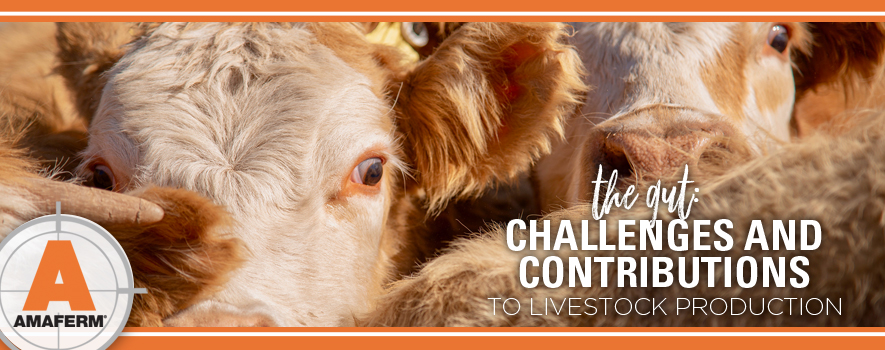
It is no secret that producers are concerned about gut health more than ever before. But why? On the one hand, the gut is where feeds are digested and nutrients are absorbed. Without proper nutrient absorption, livestock won’t stay healthy and live up to performance expectations. On the other hand, the digestive system is the epicenter of animal health, housing up to 70% of an animal’s immune system. In many ways, the gut, via its barrier function and associated innate immune system, is the first line of defense against challenges to health.
So, what may challenge the gut?
Any type of stress, including:
• Handling/processing
• Weaning
• Hauling long distances
• Diet transitions
• Shows/sales
What are the possible responses by the innate immune system?
To defend the body against a challenge, the immune system must distinguish between what belongs to the body (self) and what does not (non-self or foreign). Any substances that are identified as non-self, particularly if they are perceived as dangerous (i.e. if they can cause disease), stimulate an immune response in the body. In response, one of three things will occur:
- The Good: the innate immune system mounts an inflammatory response that eliminates the insult and restores the tissue to normal.
- The Bad: the insult is eliminated, but the collateral damage induced by the inflammatory response affects tissue function, or the insult is not eliminated resulting in a long lasting inflammatory response.
- The Ugly: the response results in chronic inflammation from the unnoticed presence of an infectious agent or persistent presence of a danger signal.
How does all this relate to the gut?
Absorption across the intestinal barrier occurs either via paracellular or transcellular pathways. Paracellular transport refers to the transfer of substances across an epithelium by passing through the space (i.e. tight junctions) between adjacent cells. When the paracellular pathway is working correctly, the pathway is size/charge selective to prevent disturbing cellular homeostasis.
When this process is hindered, leakage occurs, and pathogens can cross the intestinal lining resulting in an inflammatory response and possible disease.
Transcellular transport refers to the movement of substances through the epithelial cells, rather than passing between cells. This means that both the mucosal exterior surface and the serosal interior surface of the cells can act as ‘gatekeepers’, keeping out certain substances, while transporting others.
Infection occurs when a pathogen avoids the body’s natural “safeguards”, invades body cells, and begins to reproduce. If the immune response is quick and effective, the infection will be eliminated. If not, the infection can lead to disease. This can cause damage to host cells (i.e. impair gut integrity) and lead to diarrhea or other enteric infections that can compromise growth and performance.
Why should livestock producers be concerned?
Livestock are often confronted with a number of physical and psychological stressors that occur before intestinal development is complete. As a result, animals may eventually lose their appetite and develop severe deterioration of gut structure and function.
The most prevalent intestinal diseases during challenging production phases include:
- Obstruction of mucosal/villus growth
- Disturbed epithelial barrier function resulting in increased permeability (“leaky gut”)
- Impaired mucosal immune defense
- Microbial imbalances
Through increased government regulation and demand for increased customer transparency, livestock producers are forced to reevaluate how they can maintain performance without sacrificing animal health. Caring for the animal’s digestive system and maintaining good gut health is one avenue to achieve this. At BioZyme®, we manufacture precision biotics that help animals handle digestive challenges that may impact performance.
